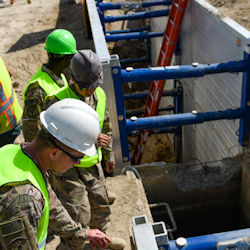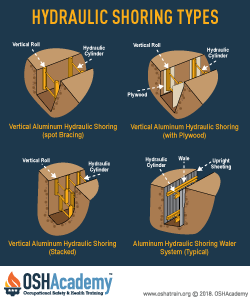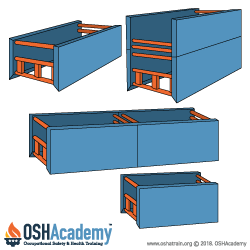Excavation Sites
To protect yourself on an excavation site you must:
- not work in an unprotected trench five feet deep or more.
- enter or exit a trench or excavation only by using a ladder, stairway or properly designed ramp that is placed within the protected area of the trench.
- not work outside of the confines of the protection system.
The type of protective method used for trenches 5-20 feet deep should be one of the following:
Sloping or benching: Sloping is cutting back the sides of the trench to a safe angle so it won't collapse. Benching uses a series of steps that approximate the safe sloping angle. The angle depends on the soil type.
All simple slope excavations 20 feet (6.11 meters) or less deep should have a maximum allowable slope of 1-1/2:1. A slope of this gradation or less is safe for any type of soil.
Shoring: Shoring is wooden, mechanical, or hydraulic systems that support the sides of an excavation to prevent soil movement and cave-ins.
Hydraulic Shoring: The trend today is toward the use of hydraulic shoring, a prefabricated strut and/or wale system manufactured of aluminum or steel.
Hydraulic shoring provides a critical safety advantage over timber shoring because workers do not have to enter the trench to install or remove hydraulic shoring.
Pneumatic Shoring: This method works in a manner similar to hydraulic shoring. The primary difference is that pneumatic shoring uses air pressure in place of hydraulic pressure. A disadvantage to the use of pneumatic shoring is that an air compressor must be on site.
Shielding: Shielding protects workers by using trench boxes or other types of supports to prevent soil cave-ins.
Trench Boxes are different from shoring because, instead of shoring up or otherwise supporting the trench face, they are intended primarily to protect workers from cave-ins and similar incidents.
The excavated area between the outside of the trench box and the face of the trench should be as small as possible. The space between the trench boxes and the excavation side are backfilled to prevent lateral movement of the box. Shields may not be subjected to loads exceeding those which the system was designed to withstand.
Designing a protective system can be complex because you must consider many factors:
- soil classification,
- depth of cut,
- water content of soil,
- changes caused by weather or climate,
- surcharge loads (e.g., spoil, other materials to be used in the trench), and
- other operations in the vicinity.
The employer must make sure all excavations and trenches five feet deep or more, but less than 20 feet, are protected by sloping or benching, trench box or shield, or shoring. There must also be adequate means of access and egress from the excavation.
If less than 5 feet deep, a competent person may determine that a protective system is not required.
Engineered Systems: Trenches 20 feet (6.1 meters) deep or greater must be designed by a registered professional engineer or be based on tabulated data prepared and/or approved by a registered professional engineer.
Knowledge Check Choose the best answer for the question.
2-6. Which protective method is required for excavations more than 20 feet in depth?
You forgot to answer the question!




